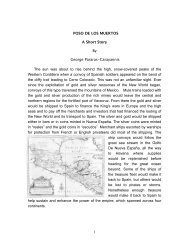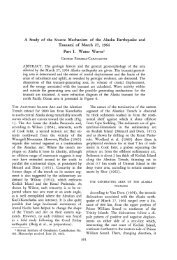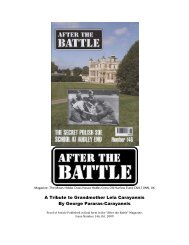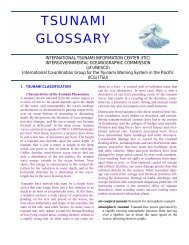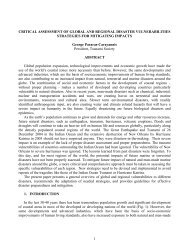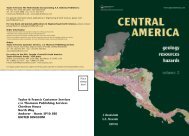Uncompressed 25.8 MB - Disaster Pages of Dr George, PC
Uncompressed 25.8 MB - Disaster Pages of Dr George, PC
Uncompressed 25.8 MB - Disaster Pages of Dr George, PC
You also want an ePaper? Increase the reach of your titles
YUMPU automatically turns print PDFs into web optimized ePapers that Google loves.
high density and relative hardness. Specifically my research at the time also involved the<br />
investigation <strong>of</strong> the crystallographic inversion <strong>of</strong> the skeletal materials <strong>of</strong> recent corals which<br />
were deposited in the form <strong>of</strong> aragonite and their conversion to the calcite crystal structure,<br />
as well as the selective substitution <strong>of</strong> calcium by other alkaline earth metals - such as<br />
barium and strontium - which had greater ionic radii. I believed that the crystallographic<br />
ratios, and perhaps the inversions were dependent on the substitution <strong>of</strong> barium and<br />
strontium by calcium and that the fossil corals at depth were slowly being altered from<br />
aragonite to calcite, paradoxically with about 8% volume expansion. I was trying to<br />
determine whether a quantitative relationship existed between the strontium (mainly) content<br />
<strong>of</strong> the corals and their aragonite-calcite ratios. My preliminary results indicated that indeed<br />
there was such a relationship. I wondered if could determine a similar relationship in the<br />
skeletal material <strong>of</strong> the deep-sea coral I had obtained. I wondered if I could find barium and<br />
possibly radioactive strontium 90 substitution in the aragonite structure.<br />
At the time there was proliferation <strong>of</strong> nuclear testing in the Pacific so strontium-90 was<br />
abundant as well as other radionuclides. Since 1945, the nuclear powers had exploded more<br />
than 2,000 nuclear devices and there had been major radioactive fallout, particularly in the<br />
Pacific region. The United States had been carrying bomb testing on Bikini Atoll since1954.<br />
The Soviets had begun major testing in 1964. The French had begun mostly atmospheric<br />
tests at the Moruroa Atoll that same year. In view <strong>of</strong> all that nuclear testing, there was a<br />
strong belief that there was radioactive contamination <strong>of</strong> many regions <strong>of</strong> the Pacific, as far<br />
South as New Zealand. But could the strontium-90 from atmospheric nuclear testing have<br />
been up taken by this deep ocean corals? This was a question that I was interested in<br />
answering. Certainly the recent surface corals could uptake radioactive nuclides, but given<br />
the depth <strong>of</strong> the water and the slow growth rate <strong>of</strong> the skeletal materials <strong>of</strong> this deep-sea<br />
coral, perhaps it was too early for strontium 90 to show up in the structure. Nonetheless, I<br />
was determined to find out, anyway - if I could.<br />
I had complete access to the Chemical Oceanography Laboratory at the University.<br />
Pr<strong>of</strong>essor Brian Pasby had given me access to all the equipment and instruments there.<br />
Also, the late Pr<strong>of</strong>essor Harry Zeitlin had given me access to some <strong>of</strong> the instrumentation <strong>of</strong><br />
the Chemistry Department at Bilger Hall, where I had been a PhD. graduate student. Also,<br />
he had provided me with ion exchange resins so I could concentrate trace elements in my<br />
samples, for subsequent controlled analyses using gas chromatography, X-rays and other<br />
analytical methods.<br />
In the following days and with great reluctance, I cut a section <strong>of</strong>f my small fragment <strong>of</strong> the<br />
precious coral, immersed it in Clorox to destroy the organic ingredients, had it cleaned and<br />
properly dried to avoid contamination, grinded it up, then begun a mineralogical<br />
investigation. As I suspected the crystal structure <strong>of</strong> my precious coral turned out to be a<br />
very dense form <strong>of</strong> wonderful aragonite. No calcite was present. It was pure aragonite, the<br />
orthorhombic polymorph <strong>of</strong> CaCO 3 . Its density being D x (g/ 3 ) 2.93. It was indeed a miracle<br />
<strong>of</strong> nature. Each <strong>of</strong> the aragonite's millions <strong>of</strong> individual structural units, repeated in all<br />
directions and formed a wonderful, compact geometric pattern - in the orthorhombic<br />
crystallographic system. Much like a diamond <strong>of</strong> the sea - but <strong>of</strong> course not as hard. But<br />
what was amazing about this coral is that it was a miracle <strong>of</strong> order and structure, created by<br />
living marine organisms.<br />
21



